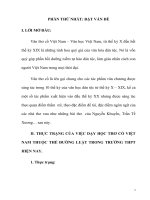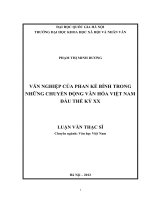Luận văn tốt nghiệp MBA Developing business strategy for viettel mobile in Viet Nam for the years 20112015
Bạn đang xem bản rút gọn của tài liệu. Xem và tải ngay bản đầy đủ của tài liệu tại đây (1.68 MB, 26 trang )
THE CAPSTONE PROJECT
THE CAPSTONE PROJECT
DEVELOPING BUSINESS STRATEGY FOR
DEVELOPING BUSINESS STRATEGY FOR
VIETTEL MOBILE IN VIETNAM FOR
VIETTEL MOBILE IN VIETNAM FOR
THE YEARS 2011-2015
THE YEARS 2011-2015
GaMBA.X0510 - Group 9
GaMBA.X0510 - Group 9
Introduction
Introduction
Necessary
Objective
To conduct the complete top-down and competitive analyses, develop
alternative strategies and select a prioritized set of strategies that will
ensure a competitive advantage for Viettel mobile in the period of 2011-
2015.
Subject & Scope of the study
- Subject: Viettel group & other competitive companies in the mobile
telecommunication industry.
- Scope: Basing on specific statistics on the macro environment, industry
and organizational environment of the Viettel from 2005 to 2010 and
orientation until 2015.
Study Approaches
Qualitative & quantitative; Statistical & analytical analyses
Structure of the study
Structure of the study
Chapter 1: Theoretical foundation of strategic management
- Concept & role
- Stages of strategic management
- Models and matrices used
Chapter 2: Analysis of business activities of Viettel
- Introduction to Viettel Group
- Business situation 2005-2010
- Business environment analyze
Chapter 3: Strategy selection & Implementation solutions
- Vision & mission
- Strategic identification & selection
- Implementation solutions & processes
Chapter 1: Theoretical foundation
Chapter 1: Theoretical foundation
1. 1. Concept & role of strategic management
1. 1. Concept & role of strategic management
1.1.1. Concept
There exist many definitions of strategic management
It is now understood to be both a scientific definition & is an art and
science of planning, organization implementation and evaluation
strategies.
1.1.2. Roles
Help to identify opportunities and threats; Help managers and employees
to understand what needs to be done to achieve success
Enable firms to match the proposed plan with the external environment; It
is in the direction of future actions
Consider as the state of art in business administration
1.1.3. Types of strategy: Corporate & business
Chapter 1: Theoretical foundation (2)
Chapter 1: Theoretical foundation (2)
1. 2. Stages of strategic management
1. 2. Stages of strategic management
External
Environment
Strategic Intent
Strategic Intent
Strategic Mission
Strategic Mission
Internal
Environment
Strategy Implementation
Business Level
Strategy
Competitive
Dynamics
Corporate
Level Strategy
Acquisition &
Restructure
Internation.
Strategy
Corporative
Strategies
Strategy Formulation
Corporate
Governance
Strategic
Leadership
Structure &
Control
Entrepre. &
Innovation
Strategic Competitiveness
Above Average Returns
Input
Feedback
Chapter 1: Theoretical foundation (3)
Chapter 1: Theoretical foundation (3)
1. 3. Models & matrices used
1. 3. Models & matrices used
STAGE 1: THE INPUT STAGE
STAGE 1: THE INPUT STAGE
External
External
Factor
Factor
Evaluation
Evaluation
(EFE) Matrix
(EFE) Matrix
Competitive
Competitive
Profile Matrix
Profile Matrix
(CPM)
(CPM)
Internal
Internal
Factor
Factor
Evaluation
Evaluation
(IFE) Matrix
(IFE) Matrix
STAGE 2: THE MATCHING STAGE
STAGE 2: THE MATCHING STAGE
Strengths - Weaknesses - Opportunities - Threats
Strengths - Weaknesses - Opportunities - Threats
(SWOT) Matrix
(SWOT) Matrix
STAGE 3: THE DECISION STAGE
STAGE 3: THE DECISION STAGE
Quantitative Strategic Planning Matrix (QSPM)
Quantitative Strategic Planning Matrix (QSPM)
Chapter 2: Business situation of Viettel
Chapter 2: Business situation of Viettel
2. 1. Introduction of Viettel
2. 1. Introduction of Viettel
History:
The first name was Information Equipment Electronics Corporation in
1989, then Military Telecommunication Electronics Company after 5 years
& Viettel Telecom Group since Dec. 2009.
Headquarter: No1 Giang Van Minh, Badinh, Hanoi
Membership units: 14 and 64 branches
Own capital: VND 50,000 Billion
Business areas:
Supply of telecommunications services; Telecommunications,
Transmission; Post Office; Terminal distribution; Finance investment;
Media; Real Estate Investment; Export & Import and Foreign Investment.
Chapter 2: Business situation (cont.)
Chapter 2: Business situation (cont.)
2. 2. Business performance of Viettel (2005-2010)
2. 2. Business performance of Viettel (2005-2010)
Revenues increased by 200% year-over-year since 2005-2009, ROE:
48.3%, Global expansion (Indochina, Africa, Latin…)
Largest mobile network: 42,200 Stations, 120,000km fiber optic net,
17/17 provinces Laos cover 3G, etc.
Revenue & profit of Viettel (2005-
Revenue & profit of Viettel (2005-
2010)
2010)
Chapter 2: Business situation (cont.)
Chapter 2: Business situation (cont.)
2. 3. Business environment analysis
2. 3. Business environment analysis
2.3.1. External environment
Macro environment (PEST)
- Economics (
E
E): GDP increment, Inflation, VND rate, etc.
Year 2005 2006 2007 2008 2009 2010
GDP (USD) 642 730 843 1052 1064 1168
Exports (USD billion) 32 39 48 62 57 71
Import (USD billion) 36 44 62 80 69 84
Remittances (USD billion) 3.8 4.7 5.5 7.2 6.2 8.1
Total retail sales and consumer
services turnover (VND1000 billion)
480 596 746 1009 1197 1561
Consumer Price Index CPI (%
change over the previous year)
8.4 6.6 12.6 19.9 6.5 11.7
Chapter 2: Business situation (cont.)
Chapter 2: Business situation (cont.)
2. 3. Business environment analysis
2. 3. Business environment analysis
2.3.1. External environment
Macro environment (PEST)
-
Politics & Legal (
P
P): Stable environment, Administration procedures &
Business law were amended and considerably improved.
-
Science & Technology (
T
T): Acquiring the advanced technologies (GSM,
3G and 4G testing in progress), Terminal production technology in
Vietnam is limited.
-
Social & Culture (
S
S): Rapidly change in the trend the new lifestyle,
Demand of using telecommunication increment, Awareness of
Vietnamese improved.
-
Demography: Population of 87 million, Over 50% under 27 years
Chapter 2: Business situation (cont.)
Chapter 2: Business situation (cont.)
2. 3. Business environment analysis
2. 3. Business environment analysis
2.3.1. External environment
Industry environment (Michael Porter - 5 Forces)
-
Rivalry: Violent competition, Viettel (36.4%), Vinaphone (28%), Mobifone
(28.8%); Many promotion programs from the rivalry.
-
Threat of New Entrants: Indochina Telecom with MVNO, Winmax 4G and
other telecommunication services
-
Power of Buyers: Many providers, Loyal & Prepaid customers
-
Power of Suppliers: Financial & Terminal providers
-
Substitute Products: Voice & Video conferencing services.
Evaluation of external environment
Chapter 2: Business situation (cont.)
Chapter 2: Business situation (cont.)
Factors of external environment
Factors of external environment
Weight
Weight
Impact
Impact
Mark
Mark
Opportunities
!"#
$%
&'
Challenges
( ) )
*'
" )
(%"
*
Total 1 3.09
Viettel’s external factor evaluation matrix (EFE)
Chapter 2: Business situation (cont.)
Chapter 2: Business situation (cont.)
The CMP matrix compares with several companies
Successful factors
Successful factors
Weight
Weight
Viettel
Viettel
Vinaphone
Vinaphone
Mobifone
Mobifone
Rank Mark Rank Mark Rank Mark
+"
,
- ) ,
( ) , )
.
(
/'% ) , ) )
0"
1 ) )
Total 1.00 3.20 2.95 2.95
Chapter 2: Business situation (cont.)
Chapter 2: Business situation (cont.)
2.3.2. Internal environment
Resources: Tangible (Finance, Organization, Facility, Technology) and
Intangible (Manpower, Ability of innovation & creativity, Reputation)
No
No
Target name
Target name
2005
2005
2006
2006
2007
2007
2008
2008
2009
2009
2010
2010
2!34# 5 , , 6
0!34# 6 ))
*
!34#
) ) 5,
)
3"
!34#
,)) )
,
-%
!#
5) ,
5
-
!34#
) ,) 65 )
*"
!
#
5 )) 6 ))
Chapter 2: Business situation (cont.)
Chapter 2: Business situation (cont.)
Number of mobilephone subscribers (Left table) and marker-share of
mobilephone providers in 12 Dec. of Vietnam (Right figure)
No Suppliers
Subscriber
s
3 6,5
3% ,6)
/" 5,)6
7 55,
)
3
/
)
, *8. ,56
5 934$ ,6))
Chapter 2: Business situation (cont.)
Chapter 2: Business situation (cont.)
2.3.2. Internal environment
Resources
Strengths:
-
Widest coverage
-
Largest market-share
-
Attractive network package,
diversification services
-
Capital, technicians…
Weaknesses:
-
Management & operation
-
Professional degree
-
Loyal customers
-
Labor productivity…
Evaluation of
internal environment:
Staff of Viettel 2005-2010
Chapter 2: Business situation (cont.)
Chapter 2: Business situation (cont.)
Internal factor evaluation matrix of Viettel (IFE)
Internal factor evaluation matrix of Viettel (IFE)
Internal environment factors
Internal environment factors
Weight
Weight
Impac
Impac
t
t
Mark
Mark
Strengths
4'%
) ,
/'%
) )
.
$%
)
) )
Weaknesses
*"1
) )
+"
&
) )
:2
Total
1.00 3.00
Chapter 3: Strategy selection & solutions
Chapter 3: Strategy selection & solutions
3. 1. Vision & Mission
3. 1. Vision & Mission
3.1.1. Vision
Leading telecommunication company in Vietnam & in the Indochina area
Providing the best products and services for customers
3.1.2. Mission
Closed collaboration between economy & defense
Investment in infrastructure
Customer-oriented business
Rapid development, continuous reforms to stabilize
Talking human as core factor
3.1.3. Core values
Practice is the criterion for testing truth;
Maturing through challenges & failures;
Quick adaptation is competitive strength;
Innovation is life; Systematic thinking; East West combination; Tradition &
method of soldiers; And Viettel is the public house.
STRENGTHS
*
84' ;
*
8&'8%
*
8*0
*
8-%
*
)
82
*
,
8
WEAKNESSES
<
8/;1
<
8+"
<
8&
<
8<'=
OPPORTUNITIES
>
8
>
8*
>
8
>
8$%
>
)
84'
THREATS
$
83
$
8*%'
$
8"
$
84?@
$
)
8*
Chapter 3: Selection & solusions (cont.)
Chapter 3: Selection & solusions (cont.)
3. 2. Strategic identification & selection
3. 2. Strategic identification & selection
SO strategies:
SO strategies:
-
9A;'B@
-
C
'8%"@
-
"
@
-
"%@
WO Strategies:
WO Strategies:
-
2" " %
1@
-
? " A
%%
-
-"@
;'@
-
*0
%@
ST strategies:
ST strategies:
-
/ " '8%
?"'@
-
"
%(;?C
-
- ' ;
@
-
"'%%
C
%
WT strategies:
WT strategies:
-
9%
"@
-
*%
A % "
@
-
(
-
. %
" " %
B@
Chapter 3: Selection & solutions (cont.)
Chapter 3: Selection & solutions (cont.)
3. 2. Strategic identification & selection
3. 2. Strategic identification & selection
Chapter 3: Selection & solutions (cont.)
Chapter 3: Selection & solutions (cont.)
3. 2. Strategic identification & selection
3. 2. Strategic identification & selection
Strategy of market penetration & development
Strategy of market penetration & development
Strategy of products development
Strategy of products development
Strategy of operations diversification
Strategy of operations diversification
Selecting strategy for Viettel in the period of 2011-2015
Selecting strategy for Viettel in the period of 2011-2015
The QSPM Matrix for Viettel Group
The QSPM Matrix for Viettel Group
Important factors
Important factors
Weight
Weight
Strategies
Strategies
Market
Market
Penetratio
Penetratio
n &
n &
Develop.
Develop.
Product
Product
Develop.
Develop.
Operation
Operation
Diversi,.
Diversi,.
( ,
*
?"%
!"#
,
$%
&' , ,
Chapter 3: Selection & solutions (cont.)
Chapter 3: Selection & solutions (cont.)
( ) )
*'
" ) , )
(%"
,
* ,
4'
) ,
/'% ) ) )
.
$% ) )
) )
/1
) )
+"
& ) ) ) )
:2
Total 2.00 6.44 5.45 5.41
The QSPM Matrix for Viettel Group (cont.)
The QSPM Matrix for Viettel Group (cont.)
Chapter 3: Selection & solutions (cont.)
Chapter 3: Selection & solutions (cont.)
3. 3. Implementation solutions
3. 3. Implementation solutions
Target market and basic policies for the market
Continuing maintenance of expansion investment and improvement of
coverage quality, customer service capabilities
Continuing development of price policies for product package,
competition and flexibility for each customer segment
Management of human resources for changing the structure and
improving the quality of service from the human factor
Financial management solutions
Marketing solutions
Chapter 3: Selection & solutions (cont.)
Chapter 3: Selection & solutions (cont.)
3. 4. Implementation process
3. 4. Implementation process
Construction of annual goals
Construction of policy system and support plan
Development of action plans, budgets and implementation processes
Allocation of human resources, finance, facilities
Selection of organization structure consistent with the strategy
Strategic commitment and implementation
Strategic inspection control, evaluation and adjustment in the
implementation process
Conclusions
Conclusions
Development of business strategy for a service business production unit
is extremely important, very complicated and not easy to perform
Using knowledge from MBA courses & our practices to formulate
strategic planning for Viettel for the years 2011-2015, we chosen the best
business strategy for the Group in Vietnam.
It brings the Viettel leaders a overview of works, contributes to
improvement of competitiveness and determines the optimal solutions for
stabilization and development of the Group.
However, because of limits on theoretical knowledge as well practice of
the group’s members ourselves, this study cannot be avoided
shortcomings/mistakes
We are very happy & looking forward to getting the comments, feedbacks
from the teachers & classmates .









